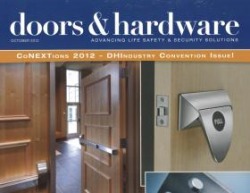Ellison President Mark Graves Authors 5-Page Article for 'Doors and Hardware' Magazine on the Anatomy of a Balanced Door
As seen in 'Doors & Hardware' October Issue | Article by Mark Graves
Saturday, October 20, 2012
When you think about it, opening a door is like shaking hands with the building. Your hand reaches out and takes hold of the door handle as it welcomes you into the building. The door makes the first impression. Entrances are usually the main focal point of a building's exterior, with the doors being the center of attention. A door's handle is generally the first and last thing a person touches when entering or leaving a building. As a result of this attention, for more than 100 years, door design and fabrication has evolved and diversified to meet a wide variety of aesthetics and functions. Walking along a city street, you'll see a variety of door styles-hinged, pivot and revolving, to name a few-made of various types of metal, glass and wood materials.
One unique style of door that has been around for more than 80 years is the balanced door. Since their invention in 1927, balanced door systems have been gracing the entrances of some of the world's most famous addresses, like the Getty Museum in Los Angeles, the Art Institute of Chicago, Smithsonian buildings in Washington, DC, the Trump Tower of Chicago, the Statue of Liberty and the new World Trade Center in New York. Throughout the world, well-known museums, libraries, government facilities, flagship retail entrances and corporate headquarters feature balanced doors.
The door, frame and balanced hardware all work together to create the complete balanced door system. The anatomy of a balanced door has been carefully crafted and perfected to produce a "marquee" entry system.
For a better understanding of a balanced door system, it is important to analyze each component. The following describes the essential parts of balanced door systems, their locations and their functions:
• Check and Door Guide Assembly: The assembly is located in the frame header above the door. A pivot shaft connects to the fixed end, while the other hydraulic half is removable for any necessary servicing without the need to remove the door leaf. The assembly contains two valves to adjust the closing speed of the door: the initial closing speed, and a second for the latching speed. Each valve can be adjusted independently of the other from the underside with ease. The guide assembly has a channel for the door roller guide to ride along when the door is being used.
• Door Roller Guide: Serves as the fulcrum, or pivot point, of the door leaf. The guide rolls along a channel located on the underside of the door guide assembly as the door opens and closes. The housing is made of cast manganese for durability. A sealed, treated bearing steel roller takes a shock each time the door is operated, so it is important for this piece to be made of extremely durable materials.
• Top Arm: One of two connections between the door leaf and frame. A 1" stainless steel pivot pin connects one end of the top arm to the door top pivot. The other end is welded to a full-height steel tube pivot shaft.
• Door Top Pivot Bearing: Located on the top rail of the door leaf. It contains a steel bearing and accepts the 1" steel pivot pin to connect the door leaf to the top arm. It is adjustable to ensure proper door clearances.
• Bottom Arm: The second connection between the door leaf and frame. The bottom arm is thicker than the top arm because it carries the weight of the door. A 1" stainless steel pivot pin connects one end of the bottom arm to the door bottom pivot. The other end is welded to a full-height steel tube pivot shaft using four penetration welds to provide superior strength. Inside of the bottom arm is a non-corrosive and self-lubricating bearing-the only plastic part in the entire door. Using plastic versus stainless steel bearings provides superior performance in the long term against water, salt, and other corrosives that may seep into this area.
• Door Bottom Pivot Bearing: Located at the door bottom rail. Accepts the 1" steel pivot pin that connects the door leaf to the bottom arm.
• Steel Tube Pivot Shaft: Houses the torsion bar closer spring. It runs the height of the door, and one end of each the top and bottom arms are welded to this shaft.
• Torsion Bar Closer Spring: Located within the steel tube pivot shaft. It provides the closing force for the door and is fully adjustable to meet the required closing pressure. The top of the bar remains stationary while allowed to turn at the bottom (on the floor box) for tension adjustments. A torsion bar is used in place of a traditional coil spring for durability. The heavy-duty design allows for the use of heavy doors and frequent operation.
• Floor Box: A base plate to accept the pivot shaft assembly. The weight of the door is distributed from the bottom arm to the floor box and ultimately down to the floor itself, eliminating the weight of the door leaf on the frame as with traditional hinged doors. The floor box permits adjustment of the door closing force via the torsion bar closer spring with a 1/2" hex key. Each time the key is turned, it moves internal gears that torque the spring until reaching the desired tension. Once the system is installed and the torsion bar is adjusted, the gears will remain stationary, leaving no need to worry about debris that may interfere with the movement. The floor box does not require much space at Y2" thick, 7" from interior to exterior, and 3%" wide. The floor box can be installed on top of an existing floor, eliminating the need for a floor cutout. The floor box is the same thickness as most threshold material. However, if a flush look is desired, for instance in an interior vestibule entrance, the thickness of the floor box will be the same thickness as most top layer floor coverings such as tile.This allows the floor box to be installed flush with the flooring while eliminating the need to cut out any of the structural concrete below.
• Semi-Automatic Hold Open: A spring-loaded attachment located on the bottom rail of the door. When engaged, this device holds the door in the full-open 90-degree position by a foot pin that slides into a hole in the threshold adjacent to the hinge jamb out of the walking area. This eliminates the need
for a brick, block or other type of object to hold the door open.
Compared to Traditional Doors
Common entry doors have a fulcrum located on one side of the door that is attached to the frame with hinges, making the user have to pull the entire weight of the door to open it. Additionally, the weight of the door leaf hangs on the frame, constantly applying force to both the hinge and the frame. A balanced door pivots at two-thirds the width of the door, distributing the weight and creating a balance that allows the door to open easily. Instead of hinge , a balanced door uses a top and bottom arm that support the door leaf. Because weight is distributed to the bottom arm, down to the floor plate, and ultimately to the floor itself, stress is transferred away from the frame, eliminating the issues created by conventional hinge-style doors.
While traditional doors have a circular arc projection, the elliptical swing path of a balanced door reduces door leaf projection by one-third, freeing up valuable space. Many cities, such as New York, have stringent sidewalk projection codes; the balanced door's reduced leaf projection is especially useful in these situations.
Space Requirements and Considerations
Balanced door sizes vary from 33" to 48" wide. Two arm (top and bottom) sizes are available to accommodate various widths. The first, type A, accommodates doors from 33" to 39" wide. This size will provide a door projection of 12'12", while the exterior door projection is 20W to 26'h'~ depending upon the door leaf width. The second size of arm, type C, accommodates doors between 40" to 48" wide. Type C arms provide a door interior projection of 16" and an exterior projection between 24" and 32".
Balanced door systems require a header that is 3" high and a minimum of 5" deep. These dimensions are required for the check and door guide assembly to be installed. Another 3" x 5" space is required vertically at the hinge side, allowing space for the pivot shaft assembly.
When a true balanced door is opened, the door leaf almost touches the jamb. It is important to remember that when the door is at a full 90-degree open position, the door leaf takes up less than 4" from the hinge jamb to the interior edge of the door. For example, if a pair of 36"-wide doors are specified, there wHI be 32" of clearance when one door is opened.
Styles and Availability
Doors and framing are available in a variety of materials, including bronze, stainless steel, steel, aluminum, wood and glass, and a variety of finishes. They are made in one of two ways, depending on the material chosen. The types of glass stops used will depend on the construction method. For instance, bronze and stainless steel are formed-up, giving more flexibility in the design and allowing pocket stops to be used if desired. Aluminum is extruded and has more limitations on design, resulting in the use of applied stops.
Balanced door leaves are available as stile and rail or tempered glass, either with or without a stile. In any of the door types, full top and bottom rails are required to accommodate the balanced hardware.
Formed-up stile and rail door construction includes minimum 2%" stiles and top rails, 6"-high minimum bottom rail (1O"-high recommended for ADA compliance), and a corner-welded internal subframe for rigidity. Door material is .09" (%2') thick minimum with internal and external parts both made of the same material For bronze and stainless steel doors, spot-welding directly through the door face creates a unitized superstructure.
Quality balanced doors are often constructed and pre-hung at the manufacturing location, allowing any adjustments to be made so that the operation of the door is honed to perfection. This process allows for easy installation and is useful for renovation applications where the building must remain accessible.
A Lasting Impression
Balanced door systems solve many issues, including heavy and oversized doors, stack and wind pressures, opening force, door leaf projection and more. Not only do they solve these technical problems, but doors can be customized to meet specific aesthetic looks. Quality balanced doors are made of durable materials that will withstand the test of time and high usage. Balanced doors are a great fit for any application in new construction, renovation or retrofit.
While the door is the first thing noticed when entering a building, it is also the last thing that is seen and touched upon exit. A balanced door is first noticed for its ease of use and beauty, and it is long remembered for leaving a lasting impression. ...Learn more about Doors & Hardware Magazine
AIA Continuing Education
Receive 1 AIA CES HSW/SD credit hour through our new online course.



